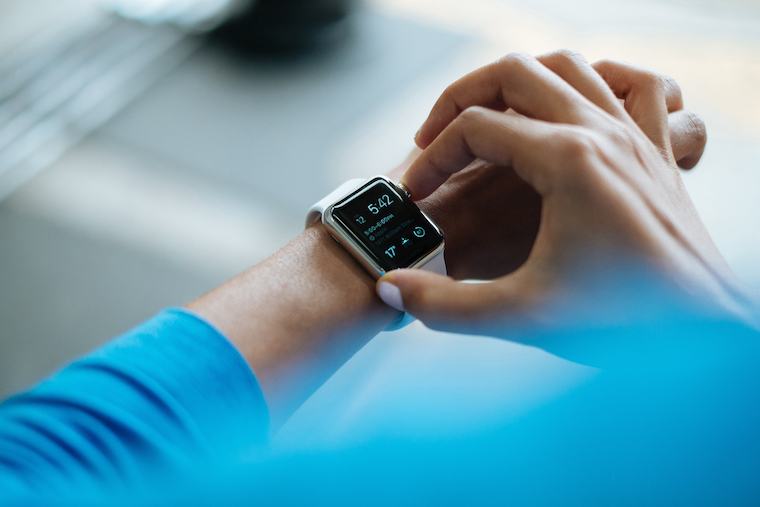Welcome to the Well+Good Healthy Pregnancy Guide, a week-long series on how SoulCycle-loving, leggings-wearing, kale salad-obsessed women can bring wellness into the next nine months (and beyond).
The notion that it’s unsafe for expectant moms to have their hearts beat more than 140 times per minute has caused plenty of women to take a, ahem, pregnant pause when it comes to prenatal workouts—and if you're just not feeling your regular 6 a.m. classes when you're busy growing another person and feeling nauseated 24/7, there's zero shame in that.
But that seemingly arbitrary bpm benchmark can be challenging for physically active women who are used to getting things pumping well above that threshold on the reg, like IntenSati instructor (and Well+Good's fitness historian) Natalia Petrzela.
“I tried the 140 bpm test a few times with my first pregnancy...but it was pretty clear that one-size-fits-all standard didn't fit me,” she says. “It was torturous to try to stay that low and still get a workout."
That’s because so many exercises that add a sweaty layer to your pregnancy glow are going to elevate your heart rate above that 140 threshold. For example, a spin class sees heart rate averages spike anywhere from 170–190 bpm, and a long, slow run ranges between 139–152. So does that mean you’re done doing cardio until you deliver, or can you pull a Serena Williams and keep rocking your regular routine?

{{post.sponsorText}}
Here's what maternal health and fitness pros say about the heart rate test—and their advice for approaching exercise when you’re expecting.

How the max heart-rate myth got started
The idea of a 140 bpm pregnancy threshold isn’t so much an urban legend as an outdated measurement for maternal health—it was introduced first in 1985 by the American College of Obstetricians and Gynecologists. Their cardio cap was extremely restrictive and based on the scant amount of research on pregnancy and exercise available at the time, which was mainly drawn from animal studies. Doctors' main concerns back then were that strenuous exercise could affect the fetal heart rate and birth weight of a baby despite a lack of evidence showing either to be true.
But since then, the science community has found significant proof that working out while pregnant provides some serious health benefits—and the ACOG's evolved its standing on prenatal exercise several times over the past few decades to adjust to the increasingly active lifestyles of modern women. The committee of women's health care physicians now recommends expectant moms get in at least 30 minutes of moderate exercise a day (unless advised not to by their doctors). Still, despite being debunked (in 1994) by the very organization that introduced it, the myth of the 140 bpm persists—kind of like the misconception that all fats are bad for you. So is there actually a max heart rate for moms-to-be?
“Heart-rate monitoring is an outdated and old recommendation for assessing how hard your body is working during your workout,” says women’s health expert and OB/GYN Sherry A. Ross, MD. “If you exercised regularly before you got pregnant, then you don’t have to worry about monitoring your heart rate during exercise. Currently there's no specific recommendation for your heart rate during exercise for pregnant women.”

Measuring max exertion
But just because it’s technically okay to hop in the saddle and tap it back in a spin class like Beyoncé, that doesn’t necessarily mean you should.
When it comes to how hard you can push yourself during a work out, “each woman is different,” says Malissa Wood, MD, co-director of the Corrigan Women's Heart Health Program at the Massachusetts General Hospital Heart Center. “We do recommend that they exercise no harder than the level at which they're still able to carry on a conversation while exercising.”
This method is known as the “talk test,” and Dr. Wood advises that a healthy heart rate is anywhere from 110–150 bpm, depending on the fitness of the mom. (But that number could potentially be higher depending on her activity level prior to pregnancy.) The key is to not push to the point of feeling lightheaded, short of breath, or exhausted. For many active women who are used to working out at a certain level before getting pregnant, these more individualized assessments are far more useful.

Sweating for two
Among the supporters of the shift in exercise safety measures are Paola and Pamela Del Hierro (who are known on Instagram as The Iron Twins). The fitness instructors and endurance pros are trainers at the Spartan Gym in Miami—and happen to currently both be pregnant. The duo say they prefer monitoring their activity levels using measurements that take their overall fitness into account.
“We’re in great shape—and because we’re athletic people, we [can] keep doing what we were doing," Paola says. “We’re focusing on light-weight, high-rep exercises/circuit training at moderate intensity—on a scale of 1–10, we would say 6–7.”
The twins are staying away from high-impact workouts that could be hard on their joints, like box jumping, jumping rope, and running on cement, as well as sit-ups, heavy lifting, and inversions. Instead, they favor things like plank exercises, beach, runs, and knee pushups. And the Del Hierros recommend their expectant clients stay active until delivery as well. Why? "It prevents complications down the road and aids in faster recovery,” says Paola.
Consider this bpm myth busted.
Here's more healthy pregnancy advice from fitness pros. And some awesome new research that says, just like aerobic exercises, avocados are also super good for moms-to-be. (phew!)
Loading More Posts...